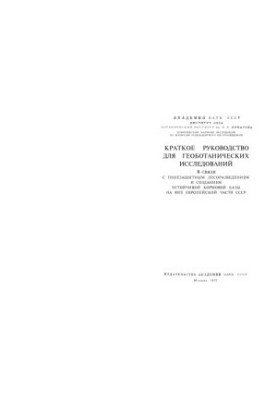A brief guide to geobotanical research in relation to field-protective forestation and the creation of a sustainable fort b
 Instant download
Instant download
after payment (24/7)
 Wide range of formats
Wide range of formats
(for all gadgets)
 Full book
Full book
(including for Apple and Android)
**"A Brief Guide to Geobotanical Research in Relation to Protective Forestry and the Creation of a Sustainable Forage Base"** is a unique publication crafted by a team of authors, representing a significant contribution to the fields of ecology, agronomy, and forestry. This book serves as an indispensable resource for students, researchers, practitioners, and anyone interested in the sustainable development of natural resources and the effective use of forest ecosystems. At the heart of the book lies the necessity of integrating geobotanical research into the practice of protective forestry. The authors delve into how to accurately assess and utilize vegetation to establish sustainable forage bases, a topic that is particularly relevant in the context of climate change and the increasing demand for food. The book not only provides theoretical foundations but also practical recommendations for conducting research, analyzing data, and applying the acquired knowledge in real-world scenarios. Who is this guide intended for? It will be especially beneficial for students and graduate students studying ecosystem sciences, agronomy, and forestry. Professionals working in environmental protection and sustainable agriculture will also find a wealth of useful information within its pages. Furthermore, it may attract anyone eager to gain a deeper understanding of the interactions between vegetation and the environment, as well as those wishing to contribute to the preservation of biodiversity and the sustainable use of natural resources. The topics addressed in the book cover a wide range of issues, from the fundamentals of geobotany and ecology to the practical aspects of creating forest plantations and forage bases. The authors emphasize the importance of a comprehensive approach to studying vegetation, which encompasses both botanical and ecological perspectives. This book is not merely a collection of theoretical knowledge; it is a practical guide that helps readers navigate the complex questions surrounding ecosystem interactions and their sustainability. The authors' style is marked by clarity and accessibility, making complex scientific concepts understandable to a broad audience. They employ numerous real-world examples, allowing readers to see how theoretical knowledge is applied in practice. This makes the book not only informative but also engaging, prompting readers to reflect on the significance of sustainable development and environmental protection. If you are looking for books on ecology, sustainable agriculture, and forestry, then **"A Brief Guide to Geobotanical Research"** will be a valuable addition to your library. It can be compared to works such as **"Ecology and Ecosystem Management"** or **"Sustainable Forestry: Principles and Practice."** Readers interested in ecosystem services and biodiversity conservation will also find much of value in this book. In summary, this guide not only enriches the reader's knowledge but also inspires action towards environmental protection and sustainable development. It will help you understand how to utilize natural resources wisely and with care for the future of our planet. Don’t miss the opportunity to explore this important and timely book that could transform your perception of nature and its resources.
LF/635078371/R
Data sheet
- Name of the Author
- Collective of authors
- Language
- Russian
- Release date
- 1952
























